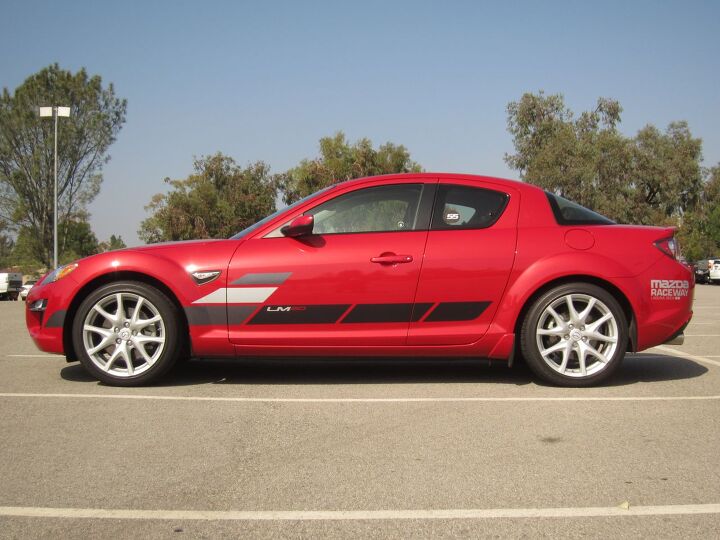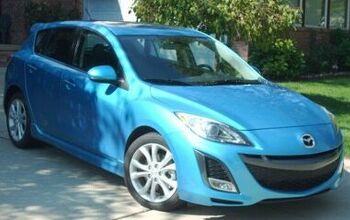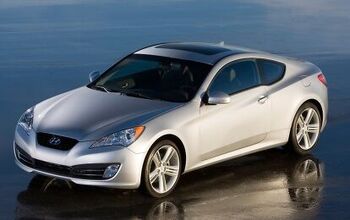Review: 2011 Mazda RX-8 Grand Touring Coupe

Way back in December, I flew out into LAX to meet up with fellow 24 Hours of LeMons Supreme Court Justice Jonny Lieberman, so that we could jump into a Mercedes-Benz SLS AMG and drive it to the Skankaway Anti-Toe-Fungal 500 race 450 miles to the north. I’d been hearing all about the magical basement full of crazy Japanese-market cars beneath Mazda USA headquarters in Irvine, so I talked Mazda engineer and superstar LeMons racer Dave Coleman into giving me the tour. But how to get from LAX to my destination many miles behind the Orange Curtain? “Coleman!” I barked, “Get me an RX-8 press car, pronto!” So, he did. Now, six months later, here comes your Better Late Than Never Review of a car that, regrettably, is no longer being built.
Why has it taken me so long to get to this? Partly because my reviews tend to be long-ass tirades that I agonize over for months, but mostly because I haven’t been able to phrase my one-sentence review in a sufficiently clever way. So, let’s get that single sentence out of the way: The 2011 RX-8 is the greatest daily driver ever made, if you can overlook the fact that it sucks gas like a ’73 Buick Electra 225. Right. Now I’ll get into the specifics.
Granted, it’s an odd-looking thing. Every time I saw its reflection in another car, I had to chuckle a bit at the cartoony front fenders. The Mazda Raceway 20th Anniversary stickers and tape stripes made me look like one of those really irritating racing geeks, the kind who drones on about trail-braking and the joys of being “at the limit.” But I would buy the non-LM20 version, and I’d get used to the strange-O styling right away.
But none of that mattered. By the time I’d left the airport, driven a few blocks on city streets, and up the onramp to the 405, I was about ready to start shopping for an RX-8 of my own.
The only Mazda rotaries I’d driven prior to the RX-8 were all mid-80s-and-earlier RX-7s, and those cars just weren’t particularly quick in stock form, nor were they particularly civilized. The ’11 RX-8 accelerates respectably hard all the way up to that ridiculous 9,000 RPM redline, and the Mazda rotary is— after 40 years— every bit as smooth as the old RX-3 ads claimed.
I ran into the usual Southern California stop-and-go traffic as I headed south down the 405, which gave me a chance to contemplate the barbed wire, gang tags, and bullet holes on all the freeway signs.
Back in Southern California, my home for most of the 1980s and the place that inspired me to create my 1965 Impala Hell Project. Mazda HQ was in the same city as the university I attended, and I hadn’t visited my old alma mater for a couple of decades. The campus would be as good a place as any to shoot some photos of the Mazda, I figured.
When I got to the campus, I headed straight to the former location of Irvine Meadows West, the students-only trailer park that was my beloved home for five years. I knew that UCI had bulldozed the place in 2004 and replaced it with a parking lot. Here’s a photo of my trailer and shotgun shack, circa 1987.
And here’s the RX-8 parked on the spot where my ’69 Roadrunner camping trailer once stood. I’ve never been very nostalgic about my college days— I was broke all the time and Irvine is a boring place to be a broke 20-year-old, plus pop music sucked worse than usual during the late 1980s— but the juxtaposition of this sporty rotary Mazda and the location of my old home got me to thinking about how I once felt about the RX-8’s mid-80s predecessor.
UC Irvine was (and is) a school with a majority Asian-American student body, and a huge chunk of that student body in the late 1980s was made up of commuter students from nearby Little Saigon, where tens of thousands of the South Vietnamese who fled Communist rule after the Fall of Saigon in 1975 ended up settling. That meant that most of my classmates had been through some serious war/refugee nightmares during their childhood, and they tended to be very serious students. The cars they drove to the campus tended to be equally serious, boring even: Malaise Datsuns, hand-me-down Detroit barges, and the occasional new Hyundai Excel.
Meanwhile, the tiny minority of my classmates who were wealthy Orange County white dudes went for brand-new Volkswagen GTIs and BMW 325s. I drove a ’68 Mercury Cyclone and a ’73 MGB-GT at the time, and I thought just about everything else I saw in the UCI parking lots was a snore.
But there was one small subset of UCI students with automotive taste I admired: the rich kids from Little Saigon who rolled in shiny new Mazda RX-7s. The RX-7, in those days, stood out as a truly cool-looking car, the kind of cool I envied.
I always assumed those sharp-dressed Vietnamese-American guys with their hot-rodded Mazdas were the sons of ARVN generals, former GVN coup plotters, and others who had left the country on first-class flights with suitcases full of C-notes and gold bars. Former South Vietnamese presidents Nguyen Cao Ky and Nguyen Van Thieu (pictured above with Lyndon Johnson) lived in Orange County, along with many of their wealthy henchmen of the war years, and being the RX-driving playboy son of one of that crowd seemed quite idyllic to me.
So, here I was with the keys to the RX-7’s successor, a car superior in every way to the RX-7. Finally, I thought, I am the coolest.
All right, enough of that flashback gibberish. What makes this car the ideal daily driver? We’ll start with its performance. This is a 3,065-pound vehicle with 232 horsepower and just 159 foot-pounds of torque, which means it’s what the racy types call a “momentum car.” Lose your momentum, you’ll be a while getting it back.
The Renesis engine is a member of the venerable 13B family, which goes all the way back to 1972. Since that time, Mazda has made it smoother, more reliable, and more powerful (though they’ve been somewhat less successful in the fuel-economy department, a subject we’ll return to in a bit). Get on the throttle and you’ll find the Renesis delivers smooth, predictable power once you get past, say, 4,500 RPM. Below that level it’s sort of a dog, so you need to throw out every piston-engine instinct you may have.
Look, there’s “13B” just visible on the rotor housing! So, momentum car: If you keep the revs up at all times, you’ll get excellent Boeing 737-style acceleration whenever you want it, but you won’t get that vision-goes-out-of-focus violence of a torquey piston-engined car. The RX-8 does the quarter-mile in the high 14s, which is plenty quick in the real world.
As for the handling, I’m not willing to push a car like this very hard any place that’s not a race track (especially not on residential streets in suburban Orange County), and my skills on a race track are nowhere near good enough to see what this thing is really made of. However, I’ve seen RX-8s absolutely hauling ass around a road course sufficient times to know that this is one serious track-day car, if that’s how you roll.
As for me, the ability to out-drag-race most other cars to a lane-merge, or to get a little sporty on twisty mountain roads without ending up flying backwards into a ravine… well, this car does that just fine. If I ever get Mr. Baruth to give me some more of his excellent race instruction, the RX-8 is the car I want to drive for the lesson. Well, that or a NASCAR-spec ’75 AMC Matador.
Getting bored with UCI, which had changed beyond recognition in the 20 years since I’d last seen it anyway, I ventured out to the Irvine/Newport Beach area… which had also changed beyond recognition. Randomly, I found myself in a little park dominated by a large statue of Orange County hero Ronald Reagan.
Now, Richard Nixon was actually born and raised in Orange County, while Reagan was a Midwestern transplant who lived north of the Orange Curtain. You won’t see many Nixon statues in Newport Beach, though. While I contemplated the cold shoulder that Nixon’s memory gets in his home county, I also thought about the things that make the RX-8 such a great everyday car.
First of all, the little suicide doors are straight-up brilliant. Back-seat passengers can get in and out easily, and you can throw your suitcases, groceries, meth-lab components, any random crap into the back seat without feeling like you’re playing a game of Twister.
The gauges and controls were placed in sensible locations, with the tachometer dominant. As it should be.
Some have griped about the dated-looking audio controls in this car, but I’ve always felt that there are only two ways you can go with this sort of thing in a Japanese car: completely berserk Mars Base weirdness (see: Subaru XT6 digital dash), or simple function that doesn’t require you to read a vernier or scroll through endless menus in order to get the Napalm Death tune on your smartphone to play through the damn stereo. Actually, I prefer the former type, but Japanese car makers seem to have fired all the spirally-eyed designers who did the really crazy stuff.
The same goes for the climate controls. No owner’s manual required here, and everything works perfectly.
The seats are as comfortable as anything I can remember, plus they have these silly Wankel symbols in the headrests.
It’s easy to parallel-park and the trunk is big enough to be useful. What else?
So, it’s lots of fun to drive, comfortable, and practical. Why did I fail to rush right out and buy an RX-8?
Here’s why: I got 15.5 miles per gallon in mostly highway driving (admittedly with some lengthy stop-and-go traffic-jam action), and I wasn’t even hammering on the car. 15.5 miles per gallon! Mazda claims this car gets 16 MPG in the city and 22 on the highway, but I don’t see how even those miserably thirsty figures could be attained in the real world unless you do some heavy-duty hypermiling in your daily commute. The RX-8’s gas tank holds 16.9 gallons, which gives a total range of somewhere around 250 to 300 miles. At freeway speed, the fuel gauge moves fast enough for you to notice.
The fuel-consumption problem, of course, comes from the tradeoffs that need to be made to get a Wankel engine to meet emission standards, plus the combustion-chamber inefficiencies of the Wankel cycle.
My two-ton ’97 Ford Crown Victoria got much better fuel economy, in town and on the highway, than does the RX-8. In fact, plenty of cinder-block-shaped SUVs get better fuel economy than the RX-8. Even though I don’t drive a hundred-mile commute every day, I know it would drive me crazy to know that I was driving a small car that swilled such oceans of gasoline. A Lincoln Town Car Congressional Series Brougham d’Landau Edition that knocked back fuel like Janis Joplin going through Southern Comfort… well, that makes sense. Likewise, a lumpy-cammed Olds 442 with a tubbed rear and Megadeth on the Sparkomatic— that car can drink up. But not a brand-new nimble sporty car.

Murilee Martin is the pen name of Phil Greden, a writer who has lived in Minnesota, California, Georgia and (now) Colorado. He has toiled at copywriting, technical writing, junkmail writing, fiction writing and now automotive writing. He has owned many terrible vehicles and some good ones. He spends a great deal of time in self-service junkyards. These days, he writes for publications including Autoweek, Autoblog, Hagerty, The Truth About Cars and Capital One.
More by Murilee Martin
Latest Car Reviews
Read moreLatest Product Reviews
Read moreRecent Comments
- SilverHawk Growing up in California, I ran the Corkscrew in a number of different low power sports cars, but nothing really fast. I had a real blast doing it in a 66 Barracuda Formula S that I could barely handle through the curves. The car had more skill than I had. Quite an experience.
- Fred This is one car I never see anymore. Where did they all go?
- Daniel Bridger The increased cost of electricity is raging faster than the government's manipulation of ICE fuel.
- Zipper69 Why the choice of a four door shell.Packing this tech into Stinger would have been awesome.
- Eric I have no desire to have an EV. Too expensive, no charging facilities within 50 miles are even planned, unproven technology, arguably even more environmentally harmful than ICE vehicles. Besides being a status symbol and to signal virtue, what's to like?











































































Comments
Join the conversation
For uninitiated doubters: https://www.youtube.com/watch?v=g5FNjyaLfC8
I've owned my 2008 RX-8 GT since June 2008 and have not had the low MPG issues many of you mentioned. This car was my DD until two years ago, when I bought a 2013 Mazda6S GT with automatic due to clutch foot issues. Even with that, I still drive it on weekends, just not the daily commute. I agree with everyone who said it's the best driver's or enthusiast's car ever made. I really enjoy showing the uninitiated the 1.3L Renesis twin Wankel engine - typical comments are "it looks like a lawnmower engine!" More than once someone has asked me, "how many cylinders does it have?" and when I say "None!" they get this shocked look on their faces. You'd think they would have heard about this car and its rotary-engine predecessors long ago. One of the other members of my Ford Probe Club (I owned 3 of those cars in the past too, and still miss my #1) who owned an RX-8 before I did, said it best. He refers to being a race driver, which he is, in his self-built AC Cobra (SCCA). "i cant say enough about how great a car the rx8 is, and especially as a race driver. ive learned a lot from it. the chassis and driving dynamic is unlike any other car, and only the tiny size and weight of the rotary can provide that. the brakes will blow your mind and there is actually more room in the rear seats than the front for larger people. "the oil squirters are much more conservative than the older rotaries. even at laguna seca i consumed less than a quart in 6 sessions. for street driving it takes about 6K miles of normal driving. did you know the probe also had oil squirters in the pistons? "the mileage is the only area where the rx8 is not absolutely tops. i got 23 in probe driving hard and get 17 driving the same way in the rx8. driving easy the probe was about 27 and the rx8 19-20. "the biggest weakness is also its biggest strength- it is a raw, merciless sports car. it is tiring to drive in traffic and always begs you to break multiple traffic laws, pass over the double yellow and threshold brake." If any of you live in California or are willing to travel, at some point I will have to sell my 6-speed manual transmission RX-8. It has only 40K on the odometer, full maintenance records through the dealer, and is in perfect condition.